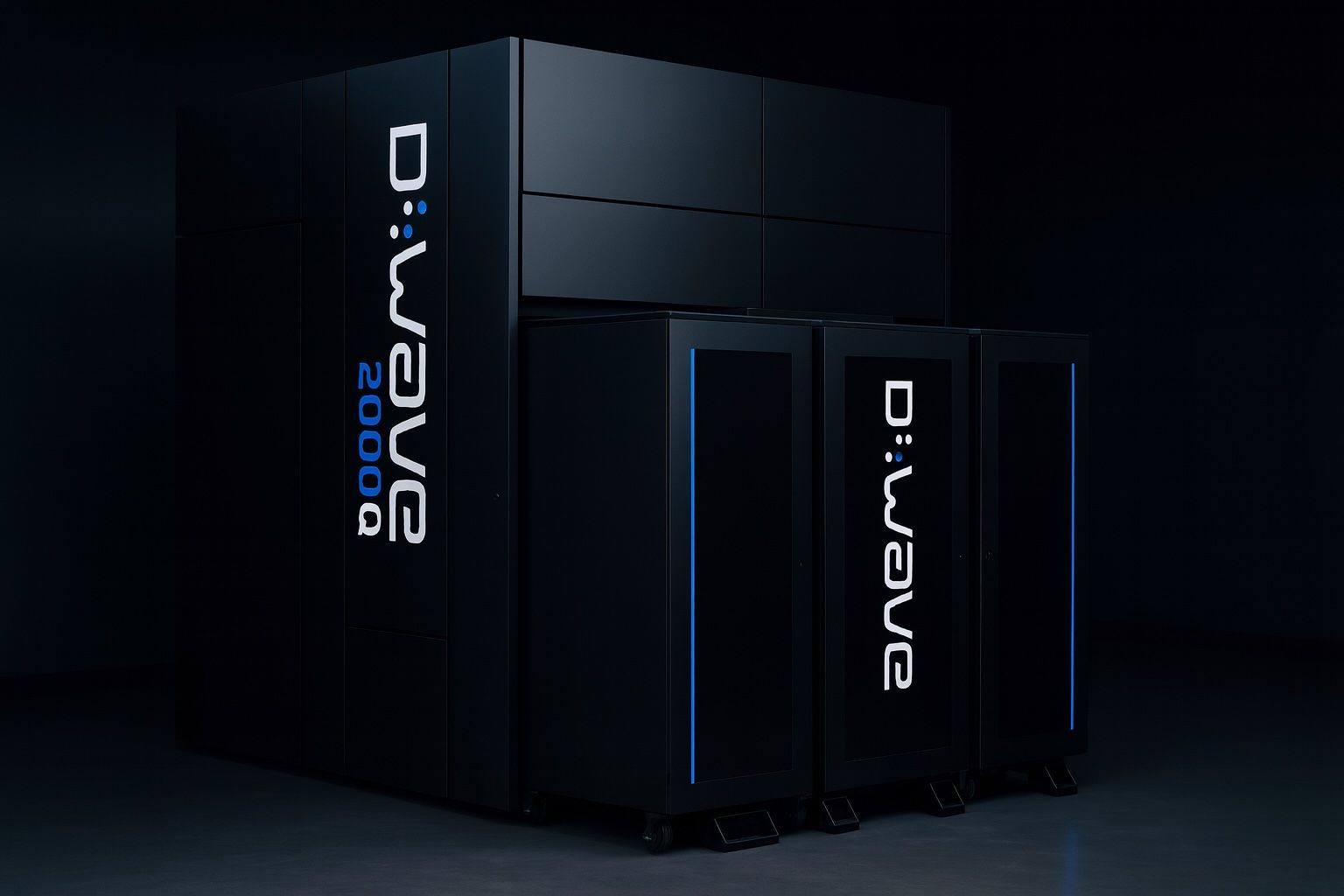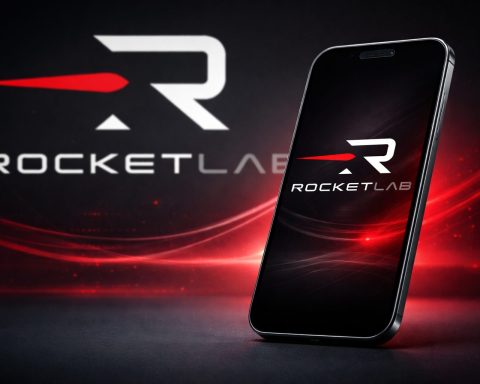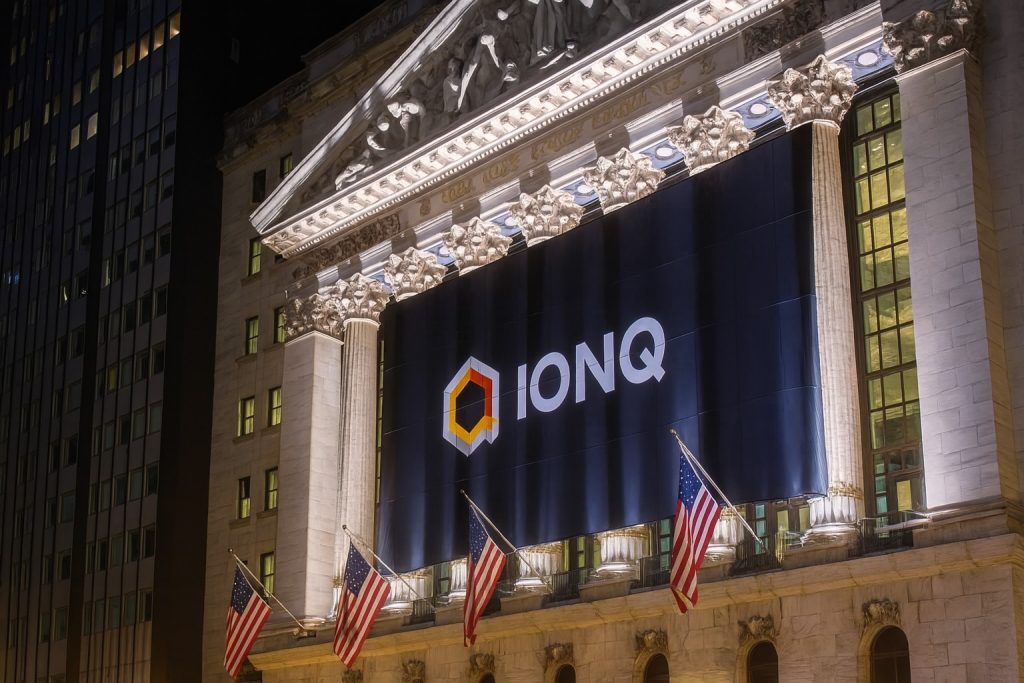- Parabolic Rally: D-Wave Quantum Inc. (NYSE: QBTS) has seen its stock explode over the past year – from around $1 in late 2024 to an all-time high of ~$46.75 in mid-October 2025, a +3,000% surge. Even after a pullback to the mid-$30s this week, shares remain up roughly 300% year-to-date and about +70% in the past month.
- Latest Move – Warrant Redemption: Today (Oct 20) D-Wave announced it will redeem all ~5 million outstanding public warrants by Nov. 19 as part of a plan to streamline its capital structure. Warrant holders must exercise (buy shares at $11.50) or lose them; if all are exercised, ~7.2 million new shares (~2.1% dilution) would be issued. The announcement lifted QBTS about 4% in pre-market trading on Monday [1].
- New European Deal: Last week D-Wave inked a €10 million (~$11.6M) agreement with Swiss Quantum Technology SA to deploy its latest Advantage2 quantum computer (with 4,400+ qubits) in Europe [2]. The system will support Italy’s new Q-Alliance quantum tech hub and be accessible via D-Wave’s cloud; SQT will control half of the machine’s runtime for 5 years with an option to buy the system. This marks D-Wave’s first large hardware sale in Europe, expanding its global footprint.
- Real-World Breakthrough: D-Wave is demonstrating practical uses of its tech. In a recent UK pilot with North Wales Police, the company’s hybrid quantum platform solved an emergency response optimization in 4 minutes instead of 4 months, cutting average dispatch times by ~50%. CEO Alan Baratz hailed it as proof that “hybrid-quantum computing…is beginning to show real-world potential” – a milestone boosting credibility for quantum computing in everyday applications.
- Analyst Upgrades: Wall Street is taking notice. Roth Capital just raised its price target on D-Wave from $20 to $50 (maintaining a Buy rating) after the European deal, saying it shows D-Wave’s tech is gaining “practical traction” with real customers. Overall, 11 of 12 analysts covering QBTS rate it a Buy. However, the average 12-month price target is only ~$27 – well below the current trading price – reflecting caution about lofty valuations despite the bullish ratings.
- Quantum Hype Fueling Surge: D-Wave’s rally comes amid a broader “quantum gold rush.” Macro tailwinds have supercharged investor enthusiasm – a Fed interest rate cut in mid-October buoyed tech stocks, and JPMorgan’s new $1.5 trillion initiative to fund “frontier technologies” (AI, quantum, etc.) sparked heavy buying of quantum computing names. Even NVIDIA’s CEO Jensen Huang recently declared quantum computing at an “inflection point” for real-world problem solving. These headlines fed a fear-of-missing-out rally in small quantum stocks.
- Valuation & Risks: Despite the excitement, red flags abound. D-Wave’s revenue remains tiny (just ~$18 million in the first half of 2025) while its market cap hit $10–14 billion during the peak – hundreds of times its sales. Market observers warn QBTS is trading on “speculation and momentum” rather than fundamentals, with one report calling the stock “significantly overvalued by virtually any measure”. The 52-week range spans from under $1 to the $40s, and technical gauges show the stock has been “overbought” amid wild 10–20% daily swings. Extreme volatility and the lack of earnings mean investors should brace for sharp moves in either direction.
Stock Price Skyrockets, Then Pulls Back
Figure: D-Wave (QBTS) daily closing stock price in early October 2025. The stock went parabolic mid-month, peaking above $45 before retreating toward the high-$30s by Oct. 20.
D-Wave’s stock has been on a rollercoaster ride in recent weeks. After trading in the mid-$20s at the start of October, QBTS shares went parabolic – rocketing to a record intraday high of $46.75 on October 15. In a single session on Oct. 13, the stock jumped over 23% intraday (topping out around $42) amid a frenzy of trading volume [3]. By mid-October D-Wave was up nearly 300% year-to-date and an astonishing ~3,000% from one year ago, making it one of 2025’s top-performing stocks.
However, the euphoria has since met reality in the form of a sharp pullback. After hitting its peak, QBTS quickly retraced about 25% as some investors took profits. The stock fell from the high-$40s down into the $30s within days. As of Monday October 20, D-Wave closed around $34–35 per share – still hugely elevated versus a few months ago, but well off its highs. Over the past 5 trading days the stock sank roughly 23%, underscoring its extreme volatility. For context, the 52-week range spans from a low of about $0.97 (last November) to the recent ~$46.75 high – a range that encapsulates D-Wave’s transformation from penny stock to mid-cap in mere months.
Notably, D-Wave’s surge has been part of a broader “quantum stock frenzy.” Other pure-play quantum computing companies like IonQ and Rigetti Computing have likewise seen their shares skyrocket by hundreds or even thousands of percent in the past year. Investors have flocked to anything related to quantum technology, betting that breakthroughs in computing power could create the “next AI” in terms of tech disruption. This broader sector momentum amplified D-Wave’s rise – and may also be contributing to outsized swings as sentiment ebbs and flows.
Recent News and Catalysts
Several fresh developments in the past week have added fuel to D-Wave’s story (for better or worse):
- Warrant Redemption Announcement (Oct 20): D-Wave kicked off this week by unveiling plans to redeem all of its outstanding public warrants. About 5 million warrants (which arose from D-Wave’s SPAC merger) are set to be cashed out on November 19 for a token $0.01 each, effectively forcing holders to either exercise their warrants (buy shares at $11.50) or let them expire worthless. The goal is to “streamline D-Wave’s capital structure” by eliminating these dilutive instruments. If every warrant is exercised before the deadline, D-Wave would issue roughly 7.2 million new shares – about a 2.1% increase in shares outstanding. The market appeared to view this move positively (as it removes uncertainty and overhang); D-Wave’s stock jumped ~4% in pre-market trading on the news [4], though it couldn’t sustain that gain through the full trading day. By simplifying its equity structure now, the company may be positioning itself for future financing or just giving shareholders more clarity, but it does mean minor dilution is likely as warrant holders convert to stock.
- $11.6M European Deal (Oct 15): Late last week, D-Wave announced a headline-grabbing international deal that observers say validates its technology’s commercial appeal. The company signed a €10 million (~$11.6 million USD) agreement with Swiss Quantum Technology (SQT) SA to deploy a state-of-the-art Advantage2 quantum annealing computer in Europe [5]. This system, featuring over 4,400 qubits, will be installed at a new quantum computing center in Italy as part of the country’s Q-Alliance initiative to build out “frontier” tech infrastructure. Notably, the deal gives SQT access to 50% of the machine’s run-time over five years (with an option to purchase the system later), while D-Wave will provide cloud access to the other half via its Leap platform. D-Wave’s CEO Alan Baratz called the agreement an important milestone in expanding global access to its annealing computers. For D-Wave, which historically has deployed systems mainly in North America, this marks its first major European sale – a signal that overseas demand for its quantum solutions is picking up. Analysts at Roth were encouraged, noting that signing a new European customer “adds support” to the view that D-Wave’s tech is gaining real traction in the marketplace. The stock was already running hot when this news hit, but such deals help legitimize the hype by showing that paying customers are on board.
- Other Partnerships & Progress: Beyond the Swiss deal, D-Wave has been busy touting its growing roster of industry and research collaborations. It recently became a founding member of a new quantum hub in Lombardy, Italy (tying into the Q-Alliance project). At its Qubits 2025 customer conference in Japan, the company reported an 83% year-over-year jump in Asia-Pacific bookings, thanks to pilot projects with major firms like Japan Tobacco (using quantum machine learning for drug discovery) and NTT Docomo (optimizing mobile network traffic) [6]. D-Wave is also working with NASA’s Jet Propulsion Lab on advanced cryogenic packaging for future 100,000-qubit processors, and signed an MOU with Yonsei University in South Korea to potentially install an Advantage2 system there. These partnerships underscore that global interest in D-Wave’s quantum solutions is broad-based – spanning government, academia, and industry – even if most projects are still in pilot or experimental phases. Each new collaboration adds to D-Wave’s credibility (and pipeline of potential revenue), which in turn has fed the bullish investor narrative around the stock.
From a big-picture standpoint, positive headlines have clearly played a role in D-Wave’s meteoric stock rise. The combination of tangible breakthroughs (like the police project and new hardware deployments) and symbolic wins (joining high-profile tech initiatives, attracting marquee partners) created a sense that “quantum’s moment” has arrived. This momentum has been turbocharged by macro events – for example, when the U.S. Federal Reserve cut interest rates in mid-October, it sparked a broad rally in tech/growth stocks (D-Wave included). Just days later, JPMorgan’s announcement of a $1.5 trillion decade-long investment in cutting-edge technologies (explicitly naming quantum computing alongside AI) sent the tiny quantum sector into overdrive. D-Wave, as one of the few pure-plays in quantum, became a poster child for this speculative fervor.
Analyst Forecasts and Market Sentiment
Despite its lack of profits, D-Wave has attracted surprisingly bullish sentiment from Wall Street analysts – though with some important caveats. As of this month, 11 out of 12 analysts covering QBTS rate it a “Buy” or equivalent positive rating. The sheer magnitude of D-Wave’s 2025 rally has prompted many firms to lift their price targets (which still lag far behind the market price). For instance, B. Riley Securities hiked its target to $33 in early October, citing D-Wave’s rapid progress toward commercial viability and noting the company’s ample cash runway to fund growth. And on October 16, Roth MKM (Roth Capital) made an even more dramatic upward revision – doubling its price target from $20 to $50 while reiterating a Buy rating. Roth’s analyst Sujeeva De Silva praised D-Wave’s recent European contract, saying the deal “adds support to [the] view that D-Wave’s quantum annealing technology is gaining practical traction.” New customer wins and real-world use cases, he noted, highlight “real-world adoption” that is central to D-Wave’s growth story. In short, the bull case from analysts is that D-Wave is successfully converting its decades of R&D into a nascent commercial business, and those who get in early could reap huge rewards if the company maintains its first-mover advantage in quantum computing.
That said, even supportive analysts urge caution after the stock’s vertical rise. The consensus 12-month price target for QBTS is only around $27 per share – which is 30–40% below the current trading price in the mid-$30s. In fact, at D-Wave’s recent peak, the gap was even larger: several analysts’ targets in the high-$20s were roughly half the market price. This disconnect implies that while analysts are optimistic about D-Wave’s technology and prospects, many also believe the stock has gotten ahead of itself. The rosy “Strong Buy” ratings are tempered by valuation concerns. As one report flatly stated, D-Wave’s stock at $40+ appeared “significantly overvalued by virtually any measure” of fundamentals. The company’s market cap exceeded $13 billion at its highs, yet full-year revenues in 2025 might only be on the order of $25–30 million. This kind of nosebleed valuation (400x+ sales) can only be justified by extraordinary growth expectations. Skeptics warn that if D-Wave stumbles in executing its growth plan – or if the quantum industry takes longer than expected to mature – the stock could see a severe reality check. In the words of one Nasdaq commentary, the recent surge could reverse just as quickly if it’s “purely momentum” without “clear profit traction” soon.
Meanwhile, market sentiment among investors and traders remains a mix of awe and anxiety. On one hand, D-Wave’s story hits all the hot buttons: revolutionary tech, AI adjacency, big-name partners, and a tiny float of shares (which contributed to outsized moves). This kind of setup has attracted fast-money traders, quantum true-believers, and speculative funds alike – fueling a frenzy that some have dubbed the “quantum gold rush” of 2025. Online forums and social media have been buzzing about QBTS, comparing its trajectory to early-stage AI or electric vehicle stocks that defied valuation norms. FOMO (fear of missing out) has clearly played a role, as many investors piled in simply because the stock was skyrocketing. At the same time, there’s an undercurrent of caution even among bulls. D-Wave’s management has been candid that quantum computing is still in its infancy commercially, and that meaningful revenue growth will take time (the company’s annual revenue is barely in eight figures currently). With that in mind, some shareholders have taken profits or hedged their positions, reasoning that a 20-fold or 30-fold gain in under a year is hard to defend without a significant change in the company’s financials.
Technical Analysis and Investor Outlook
From a technical analysis perspective, D-Wave’s stock has been in uncharted territory. The explosive rally drove shares into overbought conditions by early October – for example, the Relative Strength Index (RSI) indicator spiked well above traditional thresholds, reflecting extremely strong upward momentum. Traders noted that daily volatility became very high: QBTS saw intraday swings of 10–20% regularly, and trading volumes spiked to many times the stock’s float. Chart-wise, the stock broke out past all known resistance levels (since it was trading at all-time highs). Some technical traders set psychological levels like $30, $40, $50 as potential resistance points. Indeed, the surge stalled out in the mid-$40s – roughly a double from where it started October – and then quickly reversed. Support levels on the way down are a bit of a guessing game given the thin trading history at these prices; the stock briefly dipped to the mid-$30s, which may act as an initial support area (also around its 20-day moving average). If that fails, there could be softer support in the high-$20s (the zone of its last consolidation in late September). It’s worth noting that even after the recent pullback, QBTS remains ~350% above its early 2025 levels, so any further correction could still be within the realm of a normal retracement after a parabolic move.
Importantly, risk management is crucial for anyone involved in this stock. The past week has shown that upside volatility (on the way up) is now being matched by downside volatility. The stock’s rapid ascent has left it vulnerable to profit-taking, negative news, or broader market shocks. For instance, a single trading day like Oct. 17 saw QBTS plunge by over 15% at one point, showing how quickly sentiment can flip. Technical analysts point out that after such a climactic run-up, a period of consolidation (or even a deeper correction) would be healthy to “cool off” technical indicators. Momentum oscillators like RSI and stochastic have started to come down from extreme levels as the stock price has eased back – a potentially good sign if D-Wave is to set a more sustainable uptrend. However, if selling momentum intensifies, it could trigger stop-loss orders and lead to an outsized drop. In short, expect continued volatility: bulls and bears will likely battle over this stock’s valuation in the coming weeks, leading to seesaw price action.
Looking ahead, the investor outlook for D-Wave will hinge on its ability to turn quantum hype into concrete results. The next major catalyst on the calendar is D-Wave’s Q3 2025 earnings report, scheduled for November 6, 2025 [7]. While no one expects big profits yet, investors will focus on any signs of revenue growth (e.g. from deals like the SQT agreement) and updates on the company’s pipeline. Guidance or commentary on 2026 outlook will also be key – management’s tone could either temper the enthusiasm or further ignite it. Additionally, news flow around the quantum industry as a whole will continue to impact QBTS. Developments such as government funding initiatives, competitor breakthroughs, or macro market swings (like interest rate changes) could all sway sentiment on stocks like D-Wave.
In the big picture, D-Wave Quantum Inc. finds itself at the intersection of game-changing promise and speculative excess. The company has undeniable technological achievements – it’s the first to deliver a commercial quantum computing system, and it keeps pushing the envelope with new quantum processors and software tools. It also boasts a war chest of over $800 million in cash (thanks to a $400M financing earlier this year) to fund its R&D for the next few years, alleviating near-term liquidity concerns. These positives underpin the long-term bullish case that D-Wave could pioneer a whole new computing paradigm and eventually reap the rewards. On the other hand, quantum computing is a long game – widespread adoption could be years away, and rivals (from well-funded start-ups to tech giants like IBM and Google) are racing ahead in parallel. D-Wave will need to execute brilliantly to justify its current valuation. Any stumble in technical progress or commercial uptake could cause the stock’s speculative premium to evaporate quickly.
For now, D-Wave (QBTS) remains a high-risk, high-reward story. The stock’s recent skyrocket-and-pullback is a reminder that even in a “quantum gold rush,” gravity eventually applies. Investors bullish on the future of quantum computing see D-Wave as a trailblazer with significant upside if it continues to land customers and real-world use cases. But skeptics argue the stock has priced in a best-case scenario and could be volatile or vulnerable if that future takes longer to materialize. Bottom line: D-Wave’s journey from $1 to $40+ and back to $30s in a year encapsulates both the incredible potential and the speculative frenzy surrounding quantum computing. The coming months will reveal whether this quantum leap for investors can maintain its momentum – or if the market’s excitement collapses into a more sober reality as the technology and business mature.
Sources: Financial and news data from D-Wave press releases, Yahoo Finance, TipRanks, TS2.tech, and other market reports. All quotes and figures are sourced from verified financial news outlets and company disclosures as of October 20, 2025.
References
1. seekingalpha.com, 2. www.dwavequantum.com, 3. ts2.tech, 4. seekingalpha.com, 5. www.dwavequantum.com, 6. ts2.tech, 7. www.tradingview.com










